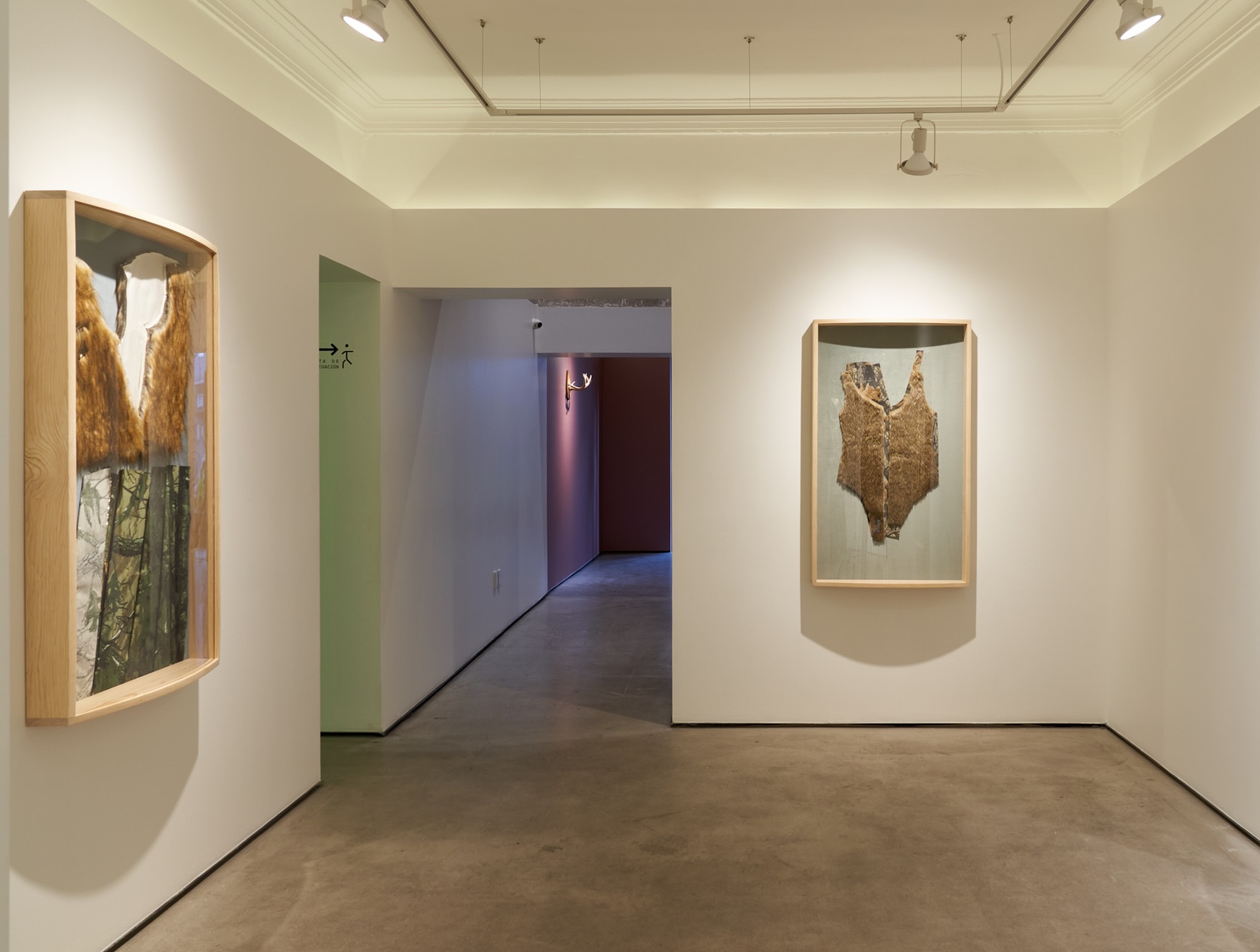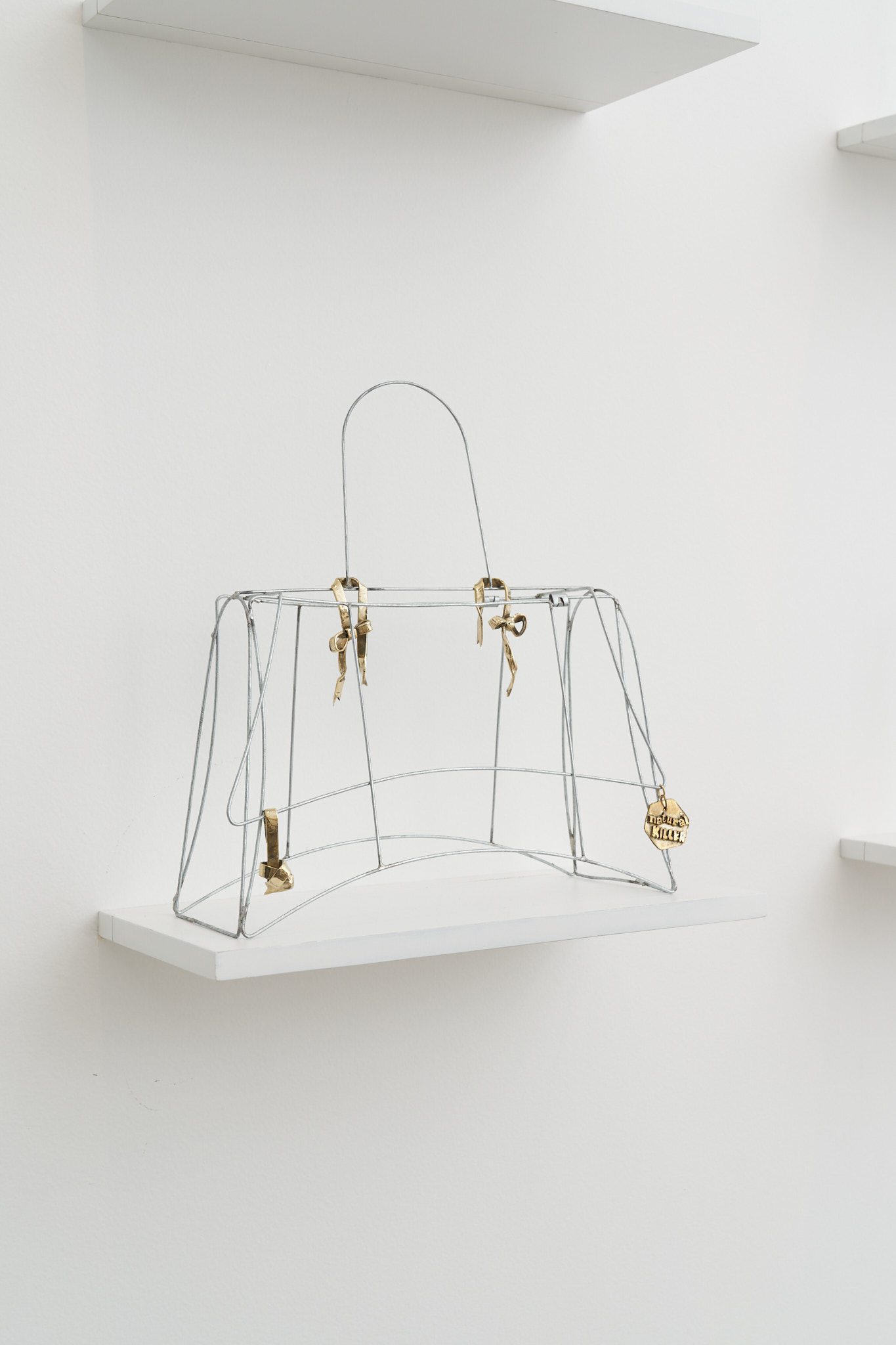
Review
'Fiera antigua que perfuma' by Cosa Rapozo at La Nao
by Andrea Bustillos
Reading time
5 min
Fiera antigua que perfuma [Ancient Beast That Perfumes] is Cosa Rapozo’s first solo exhibition at La Nao Galería. In this show, the artist transforms the gallery space into a showcase, a luxury boutique, and a hidden room which invites us to question the primal, wild desires shaped by capitalism. Rapozo’s exhibition comments on how we are domesticated by objects while exploring potential escape routes to the untamed.
A central aspect of the Guanajuato-born artist’s work is questioning the space where the pieces reside. What is or was the use of this space? What is its sense of being? I think of the recreation of the domestic setting in the exhibition Lupercalia Indómita held at guadalajara90210 in 2023, or the piece Wildlife Insights, presented at the Museo de Arte e Historia de Guanajuato as part of the Femsa Biennial XV, where the use of the diorama as a device served to make a critical statement on the function of the museum.

This time, a showcase with walls upholstered in pale pink and a few precisely lit objects draw attention and invite us inside. Without it being entirely clear whether we are entering an antique store or a room where a hunter’s —or rather, a huntress’— trophies are displayed. This is a transitional space, a prelude that neither explains nor reveals but suspends certainties. Like an adagio in a symphony or a novel’s prelude, this moment unfolds to prepare our senses and place us in a state of active anticipation. Here, what matters is not what is seen, but what is intuited—the promise of something yet to be discovered.

As we walk down a brief hallway, we enter the pristine space of a luxury boutique, where haute couture pieces are displayed, evoking the wild and the beastly through elements related to hunting, such as camouflage prints or furs. Pieces like Patronaje Pre Temporada [Pre-Season Patternmaking], framed in curved display cases, accentuate the idea of preservation. It’s inevitable to ask: what are we trying to preserve—culture, fashion, art? Inside the display cases are what could be the original patterns for a haute couture model, elevating them to a unique status that intensifies their value, appealing to the desire for possession. The display, reminiscent of a museum or gallery within what we now perceive as a boutique, blurs the lines between the worlds of art and fashion, reminding us of capitalism’s ability to trap us, even in spaces where we believe we are free.

In Charmed Cages, Rapozo presents a series of handbags made from galvanized wire and adorned with small charms of cast metal. Here, the paradox of aspiration and existential emptiness in the post-capitalist era becomes evident. The bags, transformed into cages, represent the epitome of luxury in women's fashion. It’s hard not to think of that Sex and the City episode where Samantha wants to buy a Hermès bag, and the sales clerk tells her there’s a four-year waiting list. “For a bag?” she asks, to which he replies, “It’s not a bag, it’s a Birkin.” In these pieces, Rapozo engages in an ontological exchange by placing objects with seemingly clear codes into a different field of expression. This gesture forces us to reconsider not only the belonging and meaning of these objects but also to question the systems that generate desire.

In contrast to the white, sterile light of the boutique, a small door reveals a room bathed in fluorescent green light, inviting us to enter something that feels both dangerous and seductive. The atmosphere in this room evokes the night, the rave, the venomous—I'm reminded of the colors of octopuses and poisonous animals—witches' potions and sorcery. Here, the Hechizo Predador [Predator Spell] series is presented, where the pieces take a radical turn. Black synthetic furs, decorated with gold details that evoke a bling bling aesthetic, reference non-hegemonic cultures like U.S. rap or Latin American trap. This final room seems to comment on resistance to the white, pristine aesthetics of the previous spaces, but also invites reflection on how capitalism absorbs even that which aims to be countercultural.
Like the resolution of a symphony or the climax of a novel, this room leaves visitors with more questions than answers. Upon exiting, the contrast between the green and white lights creates an optical illusion: the white room momentarily appears tinged with pink, as if a visual echo of the emotional experience. This moment of disorientation invites us to pause and reflect on what we have seen, felt, and thought. So much to contemplate, but it also leaves us with a sense of uncertainty about what’s to come in Rapozo’s work, as it is clear that there are many paths yet to be explored.
Translated to English by Luis Sokol
Published on December 31 2024